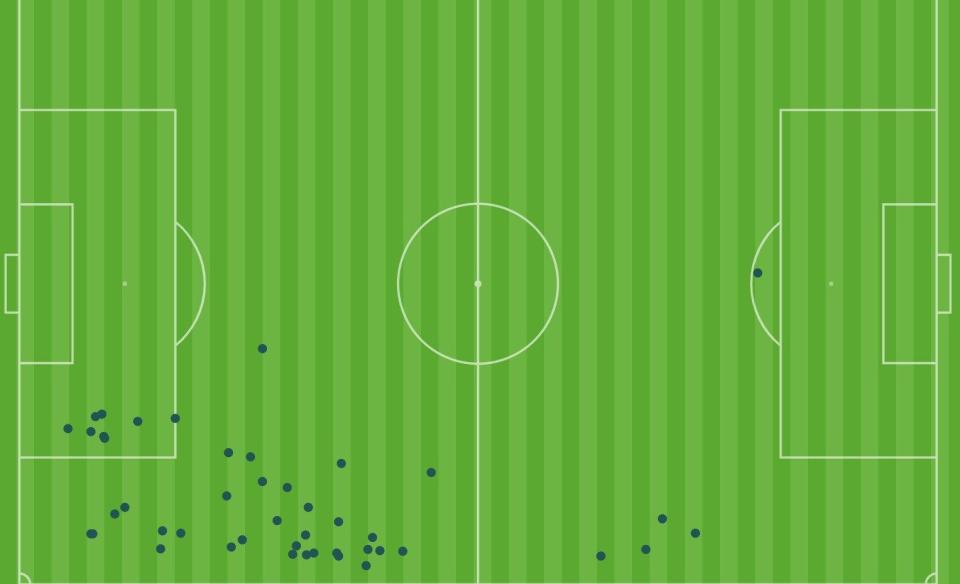Arsenal missed a golden opportunity at Aston Villa – and this is why

Villa Park appears a fortress after Aston Villa’s 15th consecutive home win, but Arsenal and Mikel Arteta will surely reflect that they missed a golden opportunity to breach it.
A Villa side sapped of energy following their consummate performance against Manchester City struggled for long periods after John McGinn finished a sweeping team move in the sixth minute.
Once again, Villa were committed to holding a high defensive line, which has won more offsides than any team in the Premier League with 75. Only two other teams have won more than 40.
High lines are a tricky thing to analyse, because it is easy to exaggerate the amount of attacking threat produced. Close offsides can feel like good chances, even though they amount to zero statistically. With a clean sheet, Emery and his players will consider it a plan well-executed.
Nevertheless, given the threat posed by Arsenal’s wingers Gabriel Martinelli and Bukayo Saka and the lack of pressure on the ball, the visitors should surely have made more of the space on offer. This is why they failed to do so.

Inefficient Martinelli
Opponents usually bank up behind the ball against Arsenal, so there are not many fixtures that offer Martinelli the chance to use his speed. This was one of them.
Arsenal were dangerous down their left flank, particularly in the first half, and it was telling that one of Emery’s substitutions was to replace Ezri Konsa with Matty Cash.
Before he was replaced by Leandro Trossard in the 70th minute, Martinelli enjoyed eight touches in the opposition penalty area. No player managed more across the contest:

However, Martinelli turned this dangerous possession into just one shot on goal, when he lifted the ball rather tamely over Emi Martinez after a clipped ball over the top by Gabriel. He did create one chance with a whipped cross towards Saka, just before McGinn’s goal.
Martinelli is averaging around two shots per 90 minutes in the Premier League this season, which is a small but notable drop-off from the peak of his volume under Arteta which was as high as 3.07, and 2.53 last season. Arsenal missed Martinelli once he was substituted, but this felt like a missed opportunity in a match tactically suited to the Brazilian.

Arsenal’s striker question
Arsenal scored 88 league goals last season despite Gabriel Jesus missing a significant period of the campaign through injury. Reaching that tally relied on players such as Martin Odegaard and Martinelli significantly outstripping their expected goals data through hot finishing.
When those conversion rates cool, it is natural that attention turns to Arsenal’s lack of a high-volume, goalscoring centre-forward.
Arsenal’s attack has been much improved since Jesus’ return from injury, and his combination play is excellent. However, a more direct threat may have been able to exploit the green grass behind Pau Torres and Diego Carlos.
Jesus looked to be away just before he was substituted in the 82nd minute, but his touch let him down. The ball also bounced off him when Saka picked him out in wide open space inside the Villa penalty area.
Arsenal’s best two chances fell to Odegaard, who telegraphed his first attempt which Martinez saved, before badly miscuing from a Kai Havertz cut-back in the second half.

Not finding the runs of Havertz
Havertz continues to look more comfortable in Arsenal’s midfield, but his team-mates struggled to find him at Villa Park.
One of the most potent antidotes for a high defensive line is late runs from midfield, in which attacker and defender find themselves moving in opposite directions.
Those movements are Havertz’s main asset, but Arsenal did not look for him enough. The German received fewer passes than any of Arsenal’s outfield players with just 12.
Arsenal have two left-footers with fantastic delivery on the right of their team - Odegaard and Saka - so in-swinging crosses and diagonal passes from right to left are a potentially fruitful avenue to goal. Havertz’s winner at Brentford was the blueprint.
Odegaard did find Havertz twice inside the penalty area, but both Saka and Jesus failed to complete a single pass to him.

No ‘third wheel’ for Saka and Martinelli
Arsenal tried and failed to sign Mykhailo Mudryk last January, which many would consider a lucky escape.
Regardless, Arsenal still lack a high-level alternative to Saka and Martinelli. A flyer who can cope in isolation against his full-back but has the speed to score goals from a high and wide starting position.
The space on offer against Villa was around the edges and in behind, so the assignment was not suited to Leandro Trossard. The Belgian is a fine technician and clean finisher when presented with the chance, but is more of a combination player than a true winger.
Arteta does not use overlapping full-backs, certainly not from the left, so Arsenal need speed and width from their left-winger. This is why Martinelli starts every game if fit.
It is highly unlikely Arsenal find an upgrade on Jesus in January, so they need their wide forwards to be dangerous. Beyond Saka and Martinelli, they feel one short.
As a battery of attacking changes, Trossard, Eddie Nketiah and Reiss Nelson lack power, presence and the pace to punish tired legs.

 Yahoo Sport
Yahoo Sport 




































































